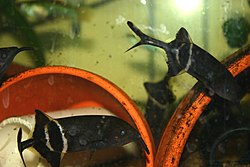Freshwater elephantfish
| Freshwater elephantfish | |
|---|---|
 |
|
| Elephant fish | |
| Scientific classification | |
| Kingdom: | Animalia |
| Phylum: | Chordata |
| Class: | Actinopterygii |
| Order: | Osteoglossiformes |
| Family: | Mormyridae |
| Subfamilies | |
The family Mormyridae, sometimes called "elephantfish" (more properly freshwater elephantfish), are freshwater fish in the order Osteoglossiformes native to Africa. It is by far the largest family in the order with around 200 species. Members of the family can be popular, if challenging, aquarium species. These fish are also known for having large brain size and unusually high intelligence.
They are not to be confused with the marine and brackish water callorhinchid elephantfish (family Callorhinchidae) of south hemisphere oceans.
The elephantfishes are a diverse family, with a wide range of different sizes and shapes. The smallest are just 5 centimetres (2.0 in) in adult length, while the largest reach up to 1.5 metres (4.9 ft). They do, however, have a number of unique features in common. Firstly, the cerebellum (part of the brain) is greatly enlarged, giving them a brain to body size ratio similar to that of humans (though other sources give the brain/body proportion as 'similar to that of birds and marsupials'; Helfman, Collette & Facey 1997, p. 191). This is likely to be related to the interpretation of bio-electrical signals. Secondly, the semicircular canals in the inner ear have an unusual structure and are associated with a gas-filled bladder entirely separate from the main swim bladder.
Some species possess modifications of the mouthparts to facilitate feeding upon small invertebrates buried in muddy substrates. The shape and structure of these leads to the popular name of "elephant-nosed fish" for those species with particularly prominent mouth extensions. The extensions to the mouthparts usually consist of a fleshy elongation attached to the lower jaw. They are flexible, and equipped with touch, and possibly taste, sensors. Their mouths are non-protrusible, and their head (including the eyes), the dorsum and belly are covered by a thin layer of skin that is perforated with small pores leading to electroreceptors. The retina of their eyes is called a "grouped retina", a type of eye structure seen in mormyrids and a few other fish. Instead of being smooth, their retina is composed of tiny cups, acting like parabolic mirrors. Because of the murky waters, the cones in their eyes have adapted to see only red light. The cups are made of four layers of light reflecting proteins, funneling red light to areas of cones, intensifying its brightness 10-fold, while the rods are hit by light from other wavelengths. Only a single gonad is present, located on the left side of their body. Mormyridae and their close relative Gymnarchus are also unique in being the only vertebrates where the male sperm cell doesn't have a flagellum.
...
Wikipedia
